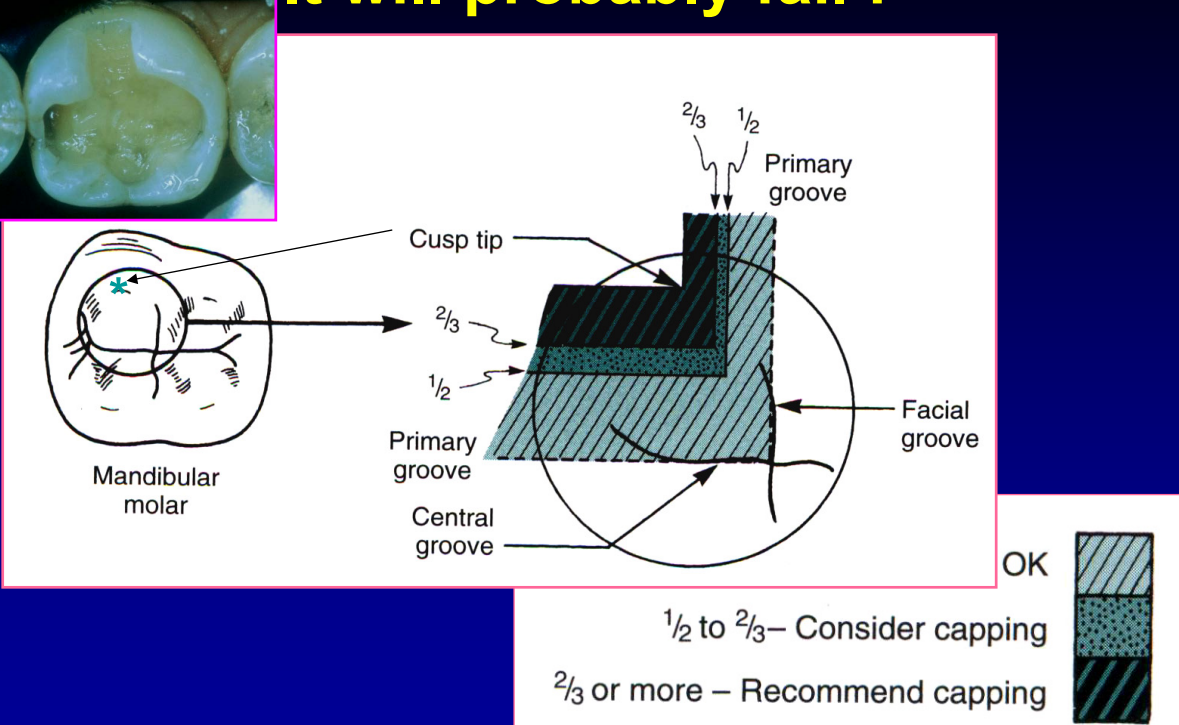Composites
1/106
There's no tags or description
Looks like no tags are added yet.
Name | Mastery | Learn | Test | Matching | Spaced |
|---|
No study sessions yet.
107 Terms
a composite can be defined as…
a union or combination of two or more insoluble materials
dental resin-based composite (RBC) = ___________________ + ____________
organic resin matrix + inorganic filler particles (monomers)
application of dental composite uses the ________ technique, followed by…
layering; pigment staining and light-curing
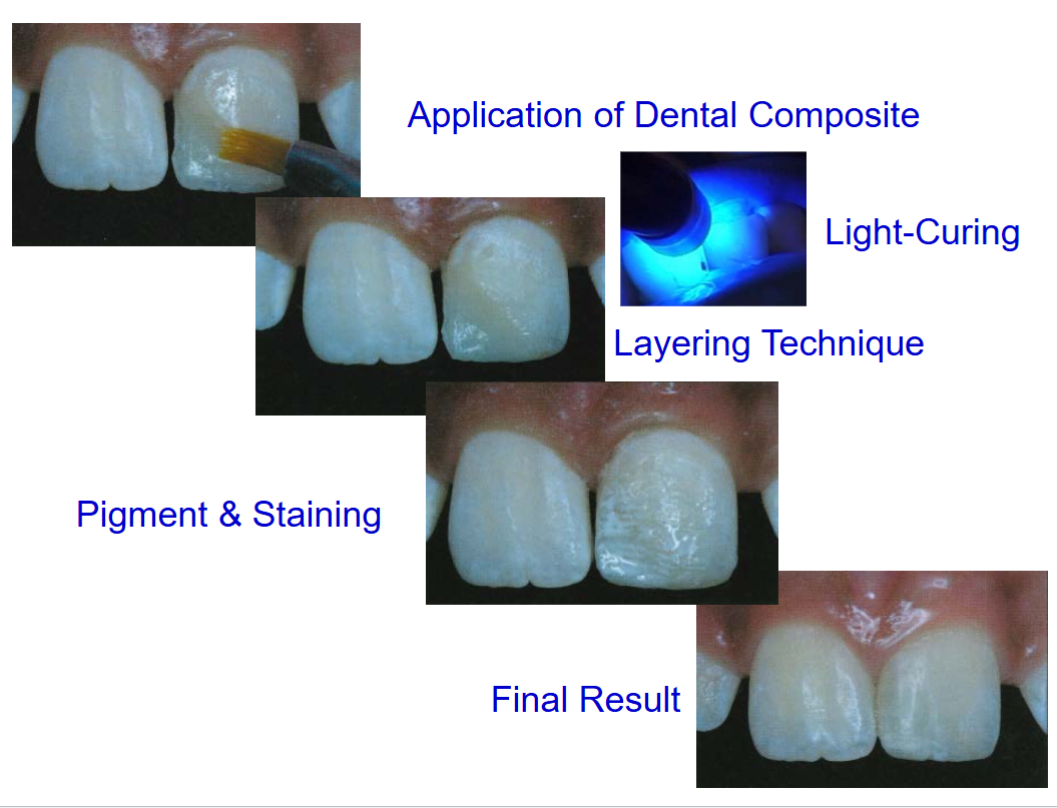
evolution of resin-based composites
monomers → initiators → filler
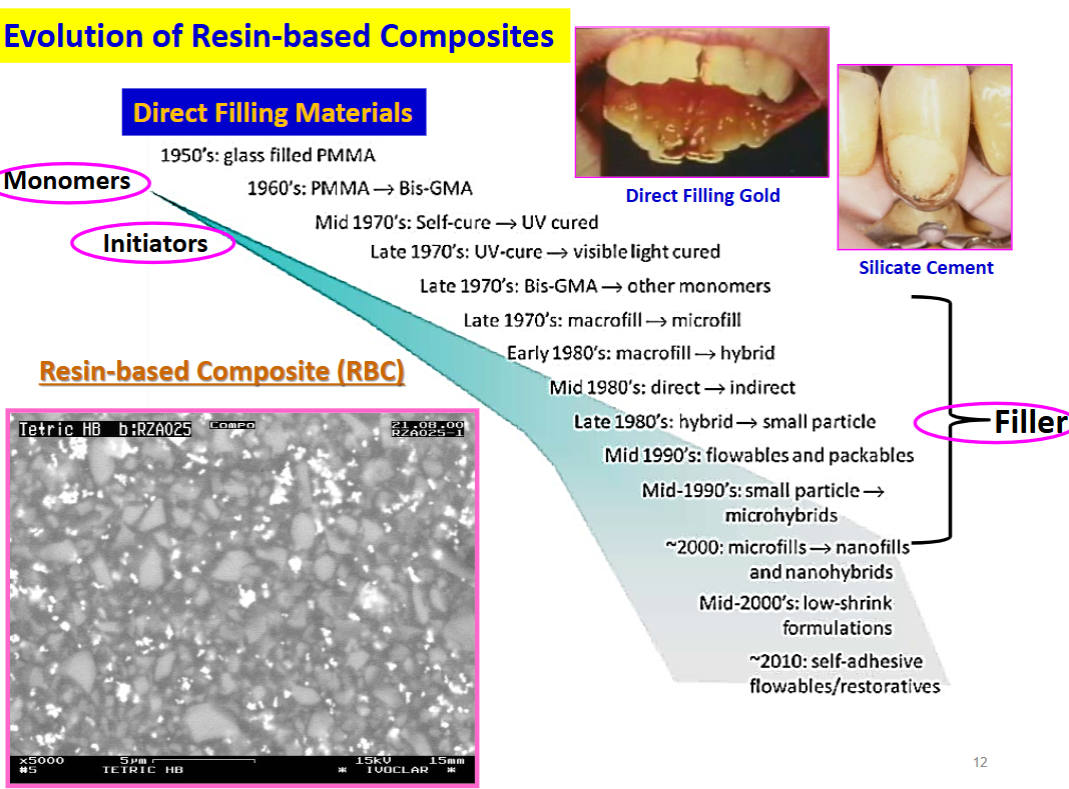
unfilled resin (PMMA, polymethyl methacrylate) has inc properties of… (4)
polymerization shrinkage
coefficient of thermal expansion
water absorption
solubility
unfilled resin (PMMA, polymethyl methacrylate) has an dec properties of… (5)
color stability
surface texture
wear resistance
modulus of elasticity (flexible/softer)
radiopacity
method of polymerization of unfilled resin
chemical cured
chemical formulas of ______________________ are commonly used in dental composites
di-functional monomers
what are the three difunctional monomers used in dental composites
Bis-GMA (bisphenol-glycidyl dimethacrylate)
UDMA (urethane dimethacrylate)
TEGDMA (triethylene-glycol dimethacrylate)
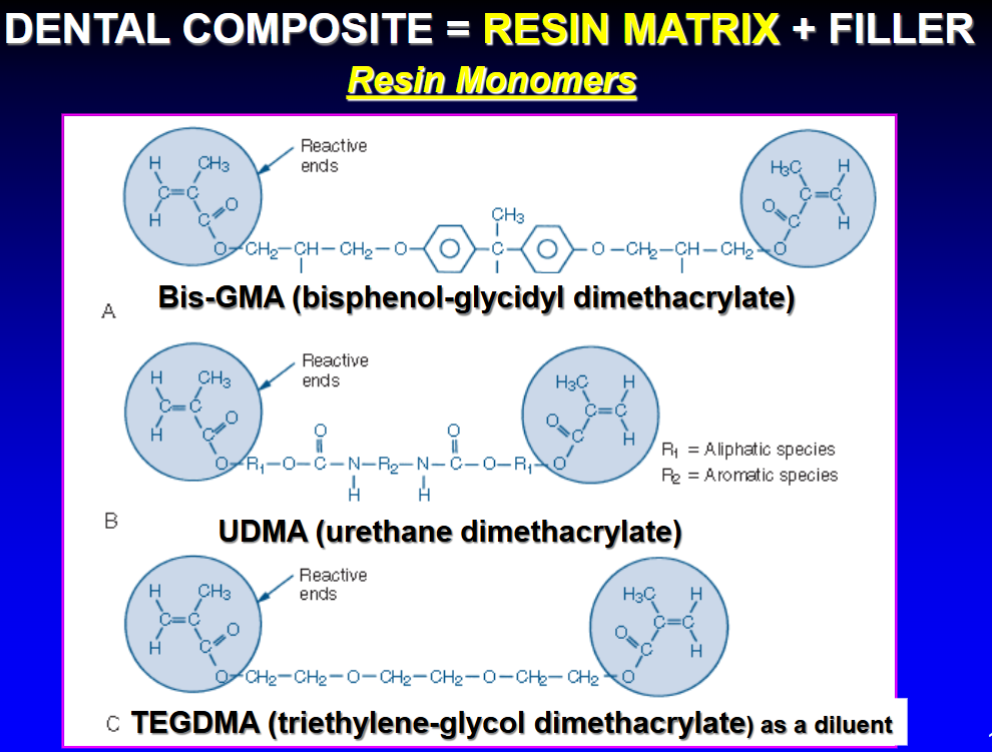
what is special about the ends of the di-functional monomers
double bonds at the end
what are the inorganic filler systems that can be used in resin-based composite (7)
silica (highly dispersed)
barium glass
Ba-Al-fluorosilicate glass
mixed metallic oxide
Yttrium fluoride
zirconia
hydroxyapatite
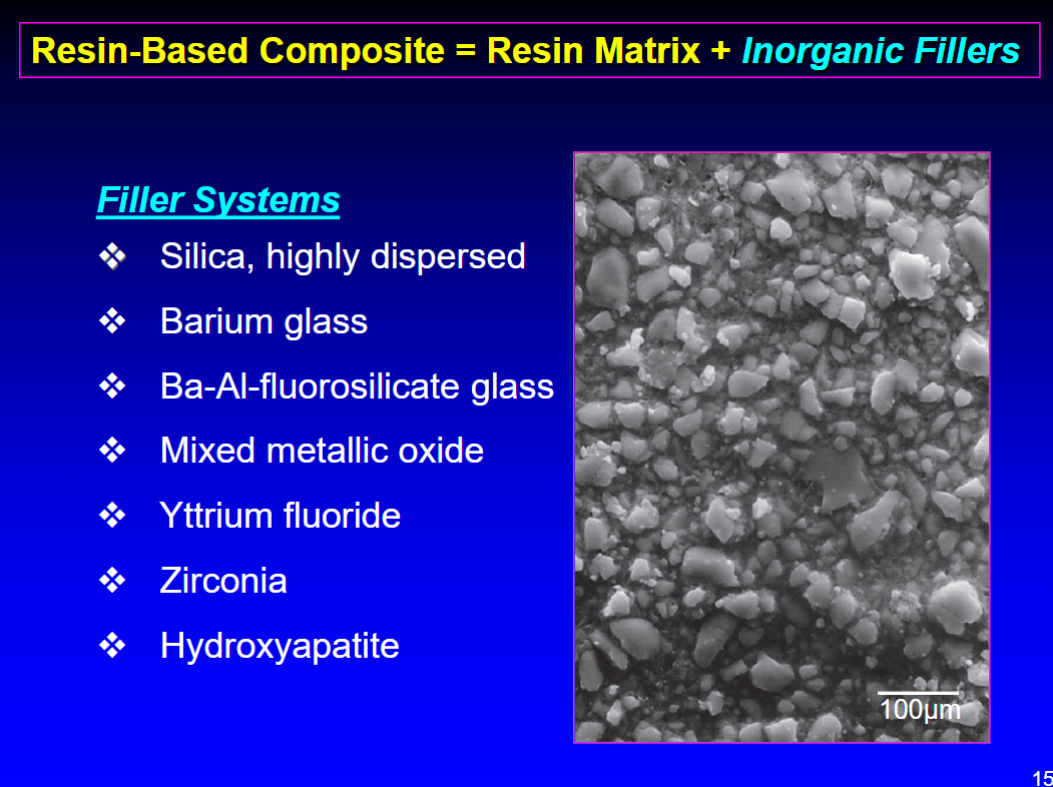
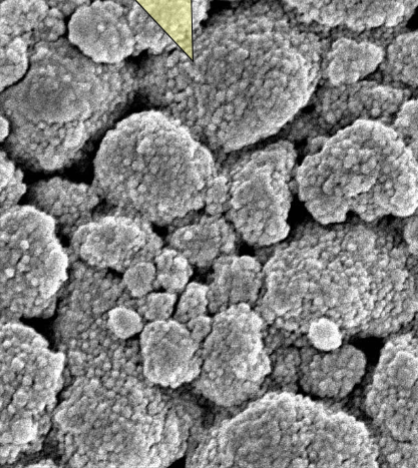
describe this particle of inorganic fillers
porous, friable nano-clusters

describe this particle of inorganic fillers
solid particles
in silane, the methacrylate group on the other end of the silane molecule can react via…
free radical addition polymerization w methacrylate groups in subsequently placed adhesives and methacrylate-based resin cements
the individual silane molecules have covalently bonded not just to the filler surface…
but to the adjacent silane molecules- essentially forming a polymer network on the filler surface
the coupling agent, silane, plays a critical role in the…
composite
what is the common coupling agent
silane
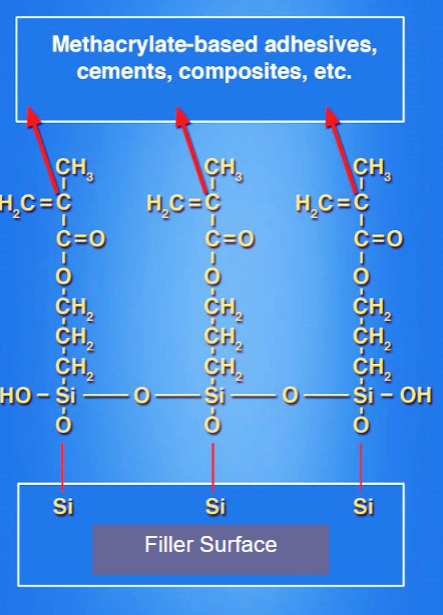
the coupling agent, silane, forms an interfacial bridge that strongly binds the…
filler to the resin matrix
the coupling agent silane enhances the mechanical properties of the ________________ and minimizes…
composite; minimizes plucking of the fillers from the matrix during clinical wear
the resulting interfacial phase of the coupling agent, silane, provides a medium for…
for stress distribution between adjacent particles and the polymer matrix
the coupling agent silane provides a ___________________ (hydrophobic/hydrophilic) environment that minimizes…
hydrophobic; minimizes water absorption of the composite
result of unfilled acrylic resin
crack
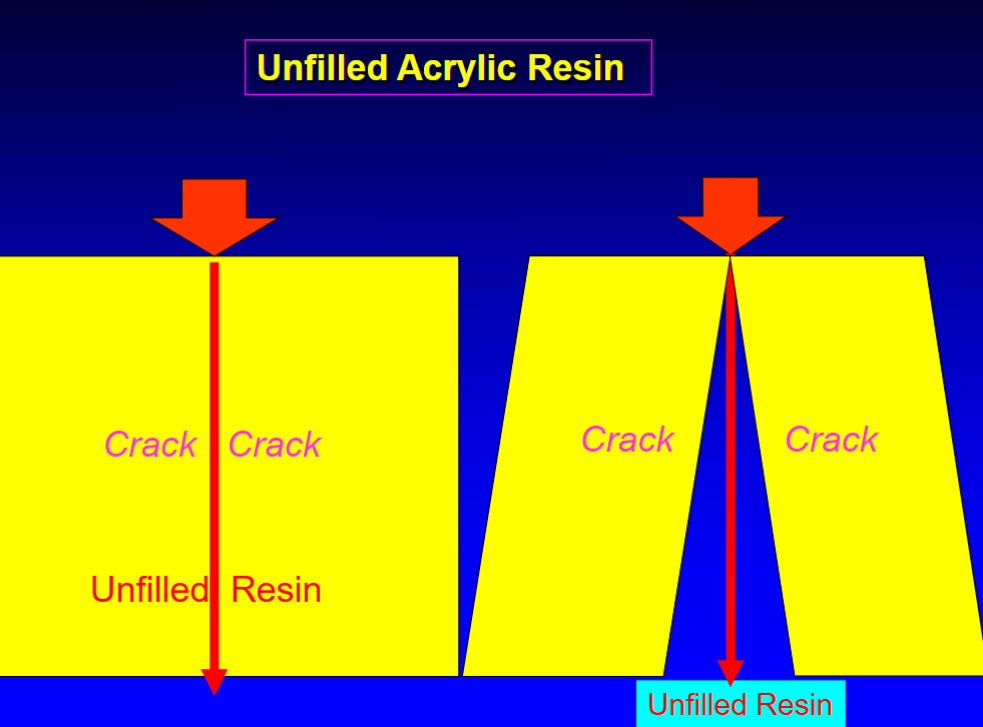
describe the structure of composite
is a set of interconnected elements that collaborate at runtime to achieve some properties; each element has some defined role in collaboration
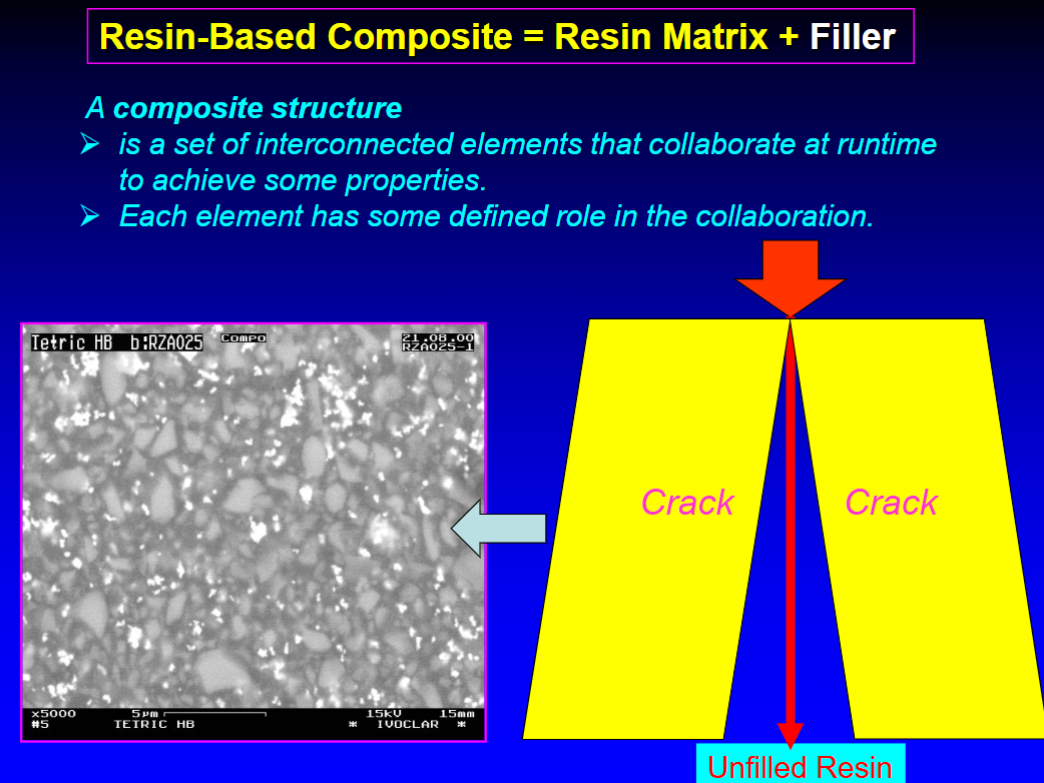
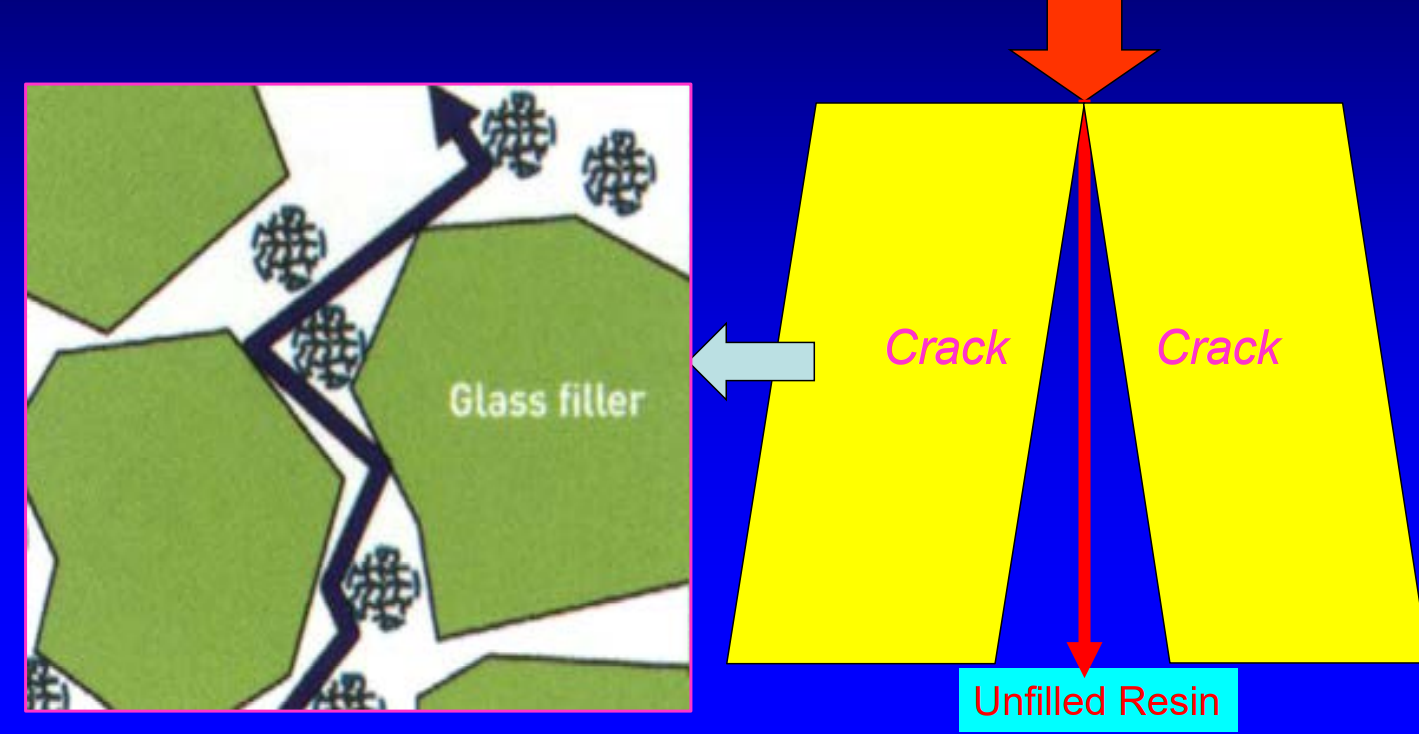
resin-based composite biocompatibility
less resin content; delay the crack propagation through the system
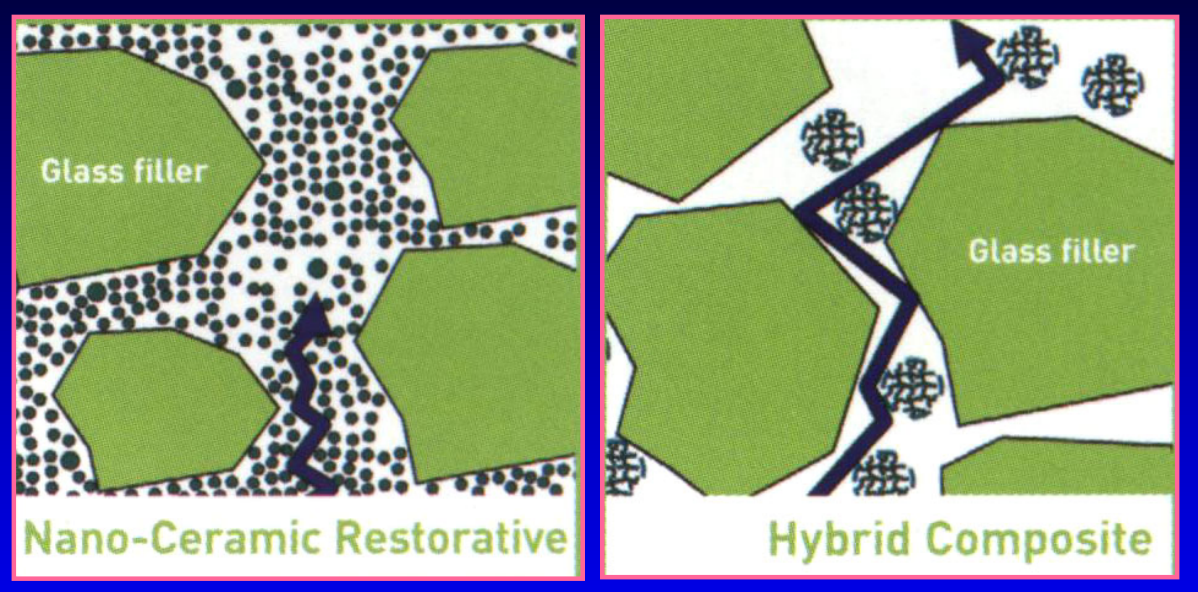
evolution and classification of resin-based composites
macrofill (1960s) → microfill (1980s) → microhybrid (1990s) → nanohybrid (2000/present)
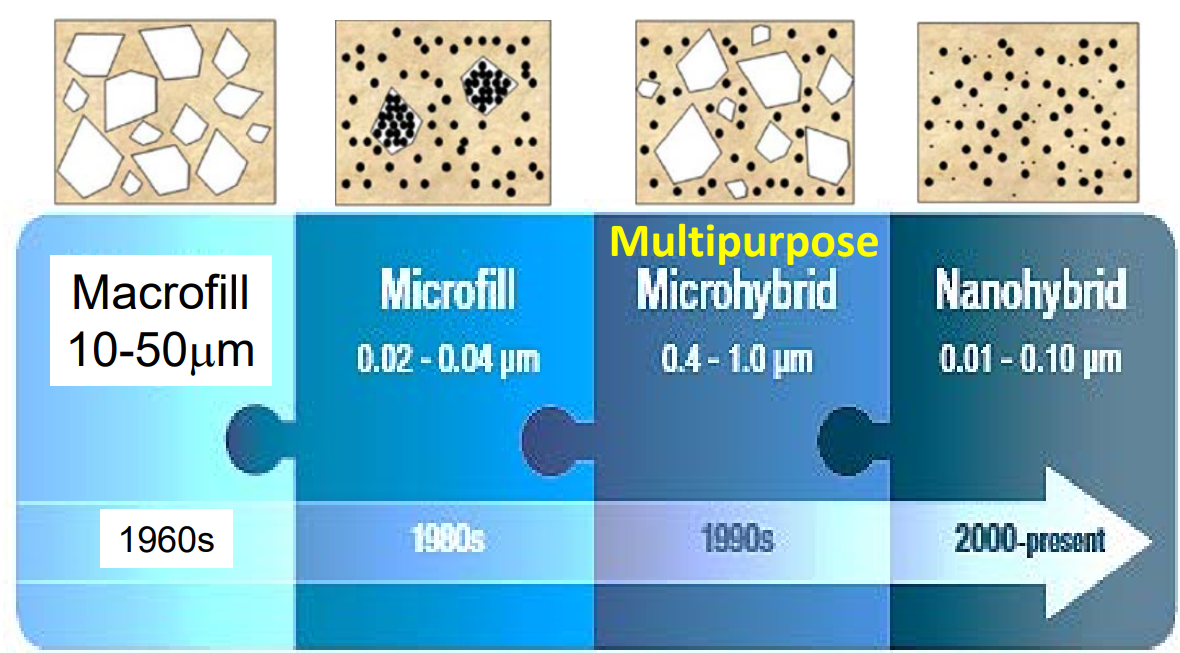
which classification of resin-based composites is multipurpose
microhybrid
classification of particle size
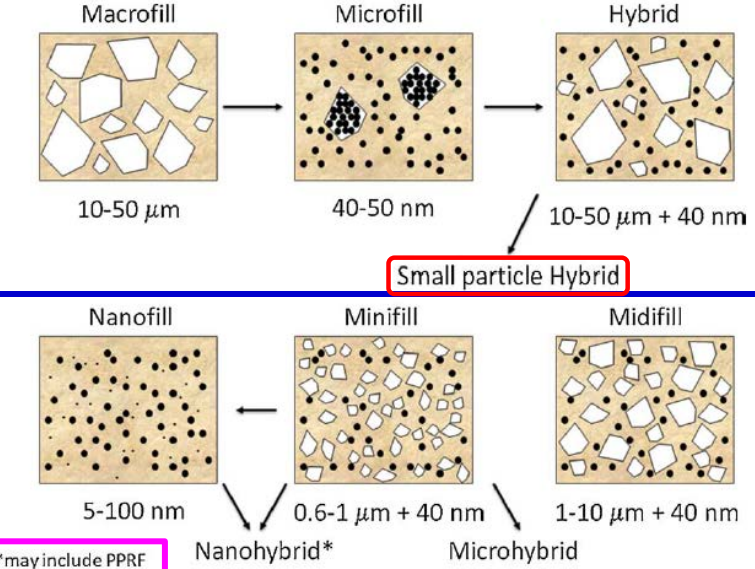
manufacturing of dental composite
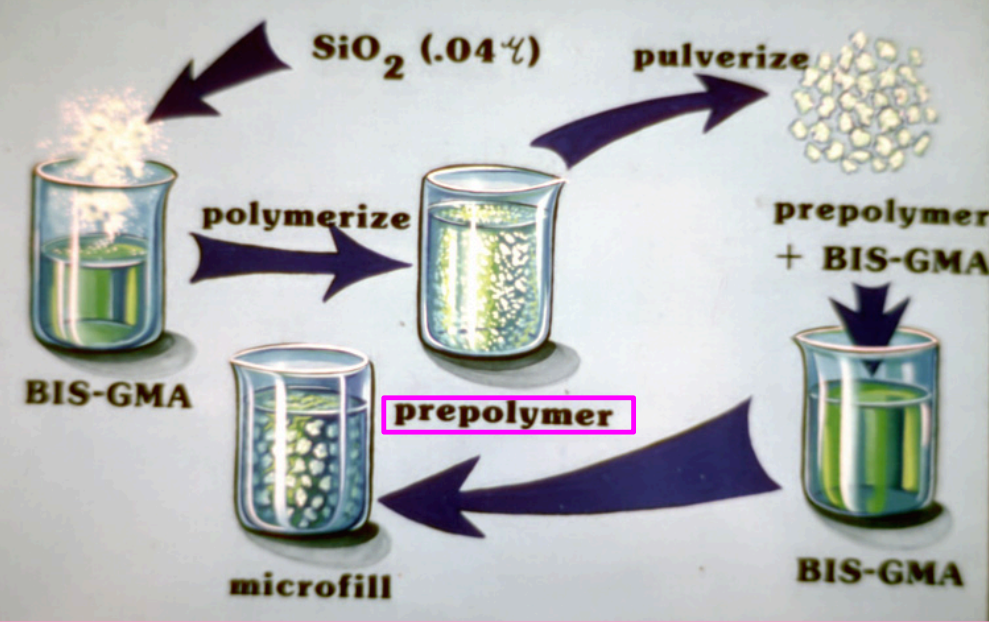
macrofill filler size
10-50 microns
microfill filler size
0.04 - 0.06 microns
hybrid filler size
1 - 10 microns + 0.04 - 0.06 microns
the hybrid classification of resin-based composite is a _________ particle hybrid
small
composite resin (Bis-GMA + filler) was introduced in the late 1960s to replace unfilled resin, it has evolved in that now, it has dec properties: (6)
polymerization shrinkage
coefficient of thermal expansion
water absorption
solubility
remained the same:
color stability
surface texture
POOR POLISHABILITY
composite resin (Bis-GMA + filler) was introduced in the late 1960s to replace unfilled resin, it has evolved in that now, it has inc properties: (3)
wear resistance
modules of elasticity
radiopacity
the major takeaway properties of composite resin (2)
improved mechanical properties
poor polishability
surface texture differences between macrofill and nanofill
easier to smooth if it is a nanofill
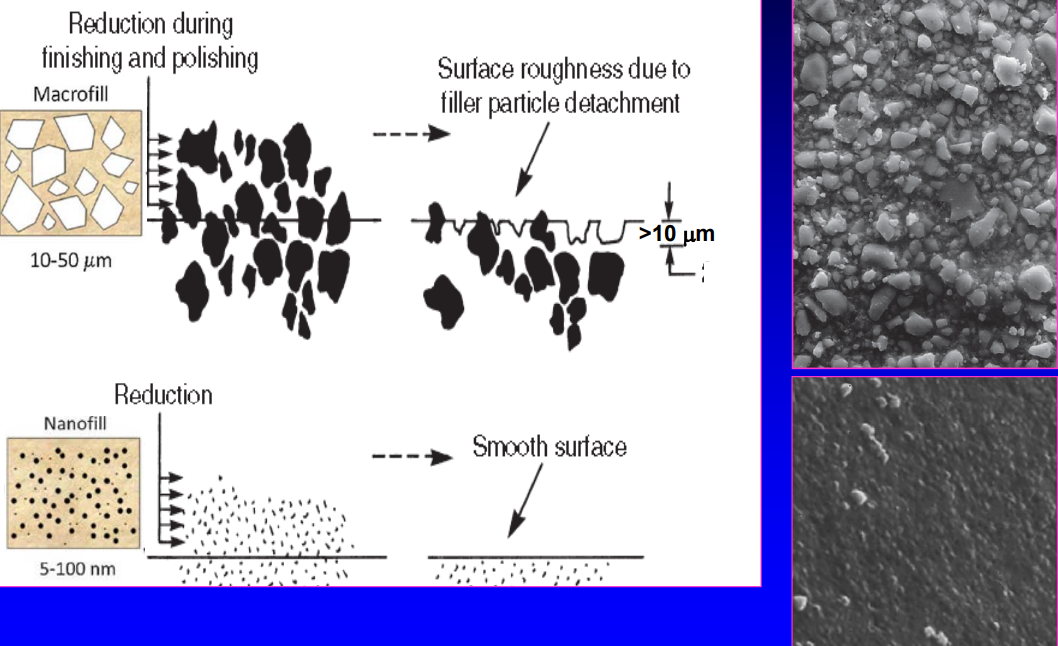
controlled wear of nanoclusters prevents…
loss of large particles allowing improved glass retention
wear surface of conventional hybrid displays…
loss of large particles and poor retention
advantages of microhybrid composite
high strength and modules
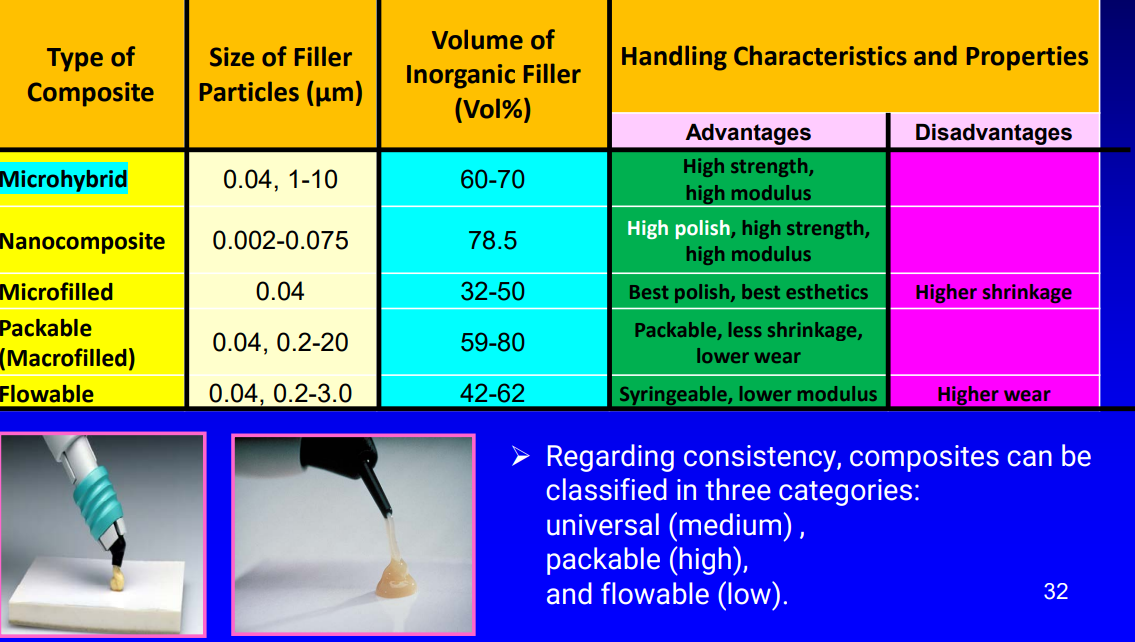
advantages of nanocomposite
high polish, strength, modulus
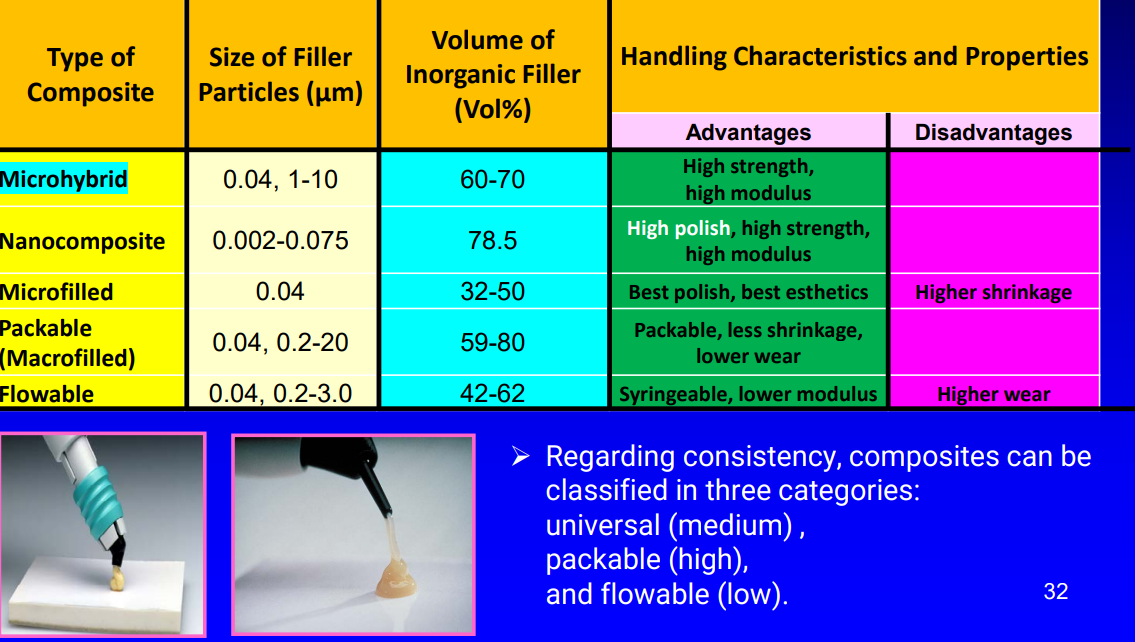
advantages of microfilled composites
best polish and esthetics

disadvantages of microfilled
higher shrinkage
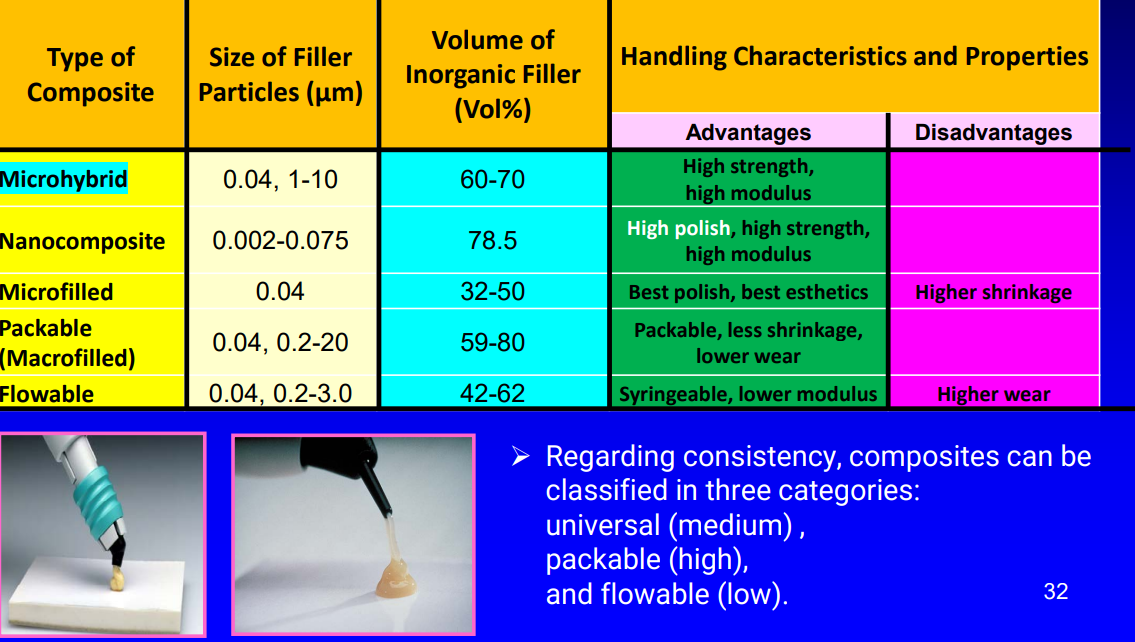
advantages of packable (macrofilled) composite
packable, less shrinkage, lower wear
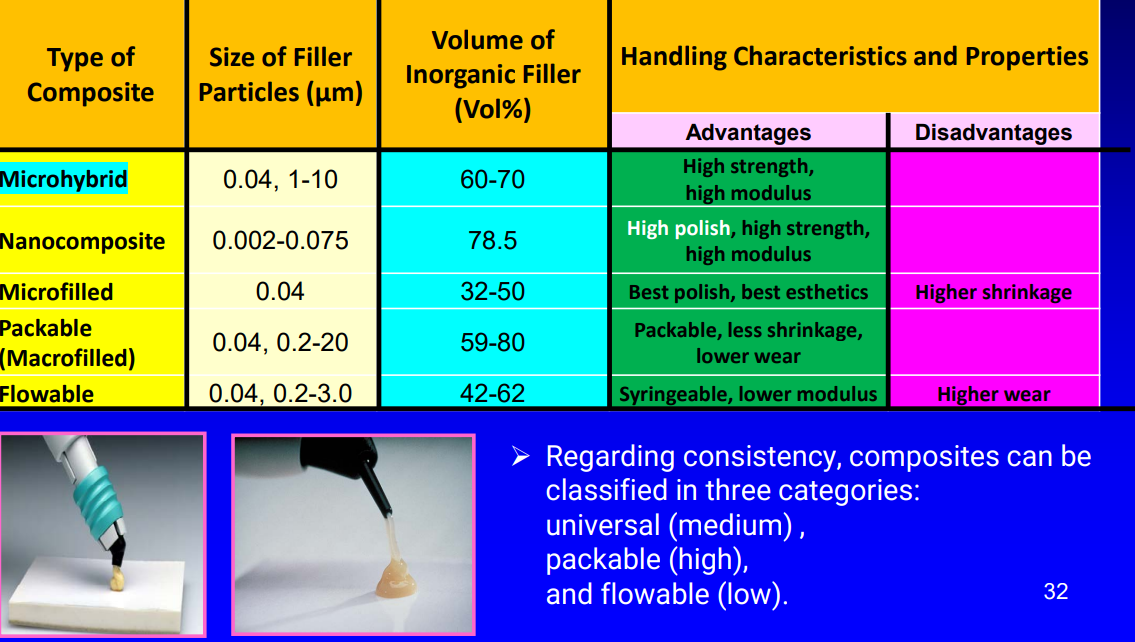
advantages of flowable
syringeable, lower modulus
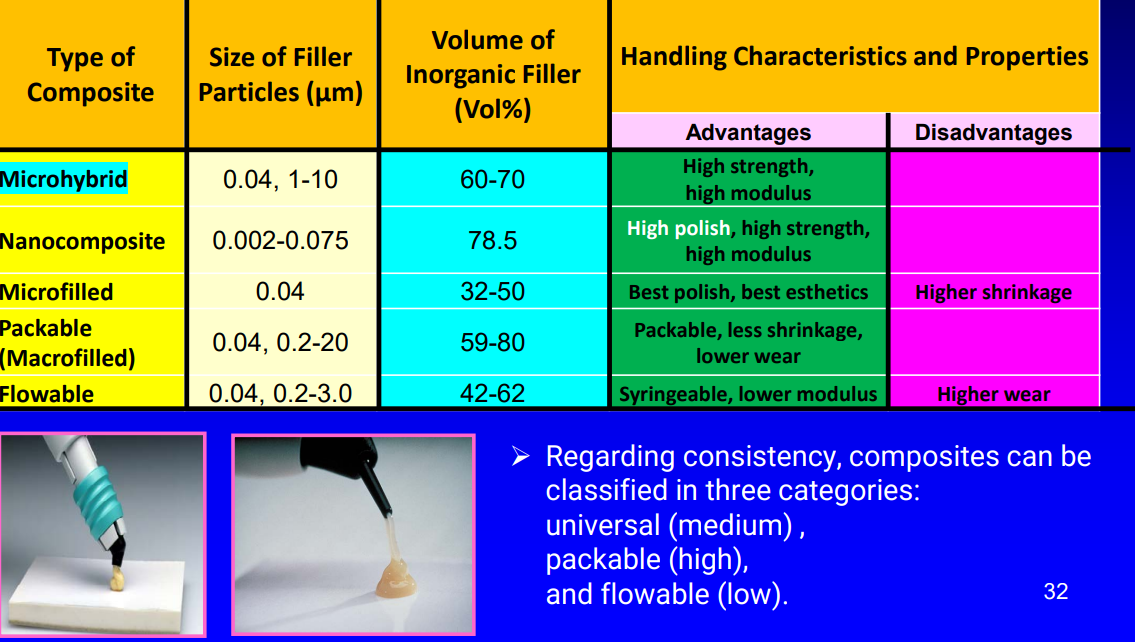
disadvantages of flowable composite
higher wear

regarding consistency,composites can be classified in three categories
packable (high)
universal (medium)
flowable (low)
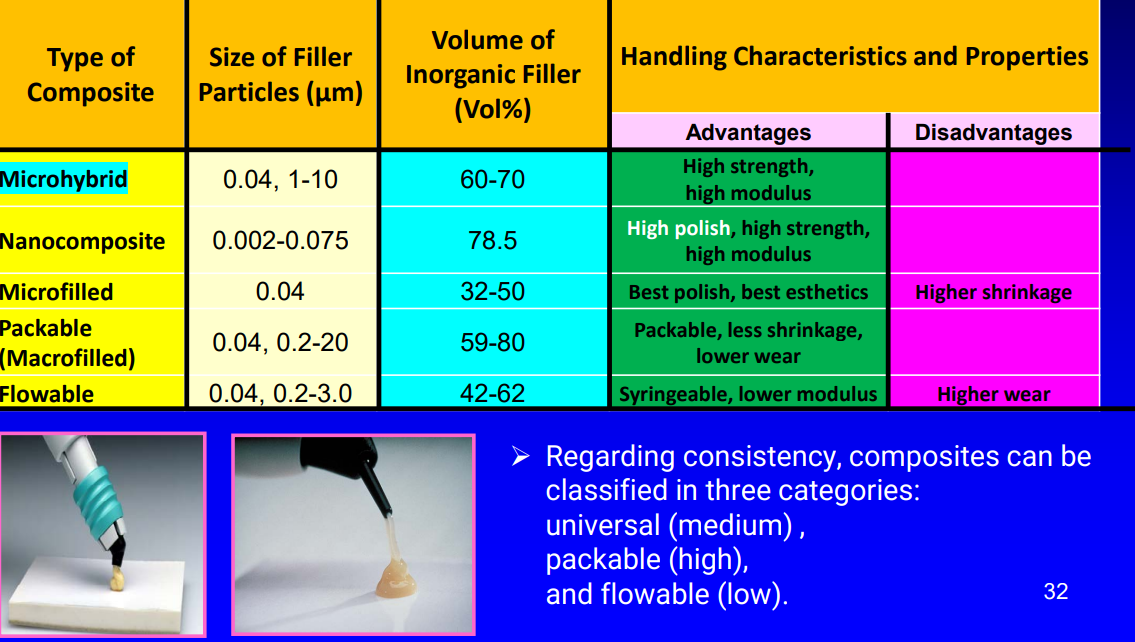
what is important to note of properties of various types of resin-based composites
there are only a few evidences in nano composites
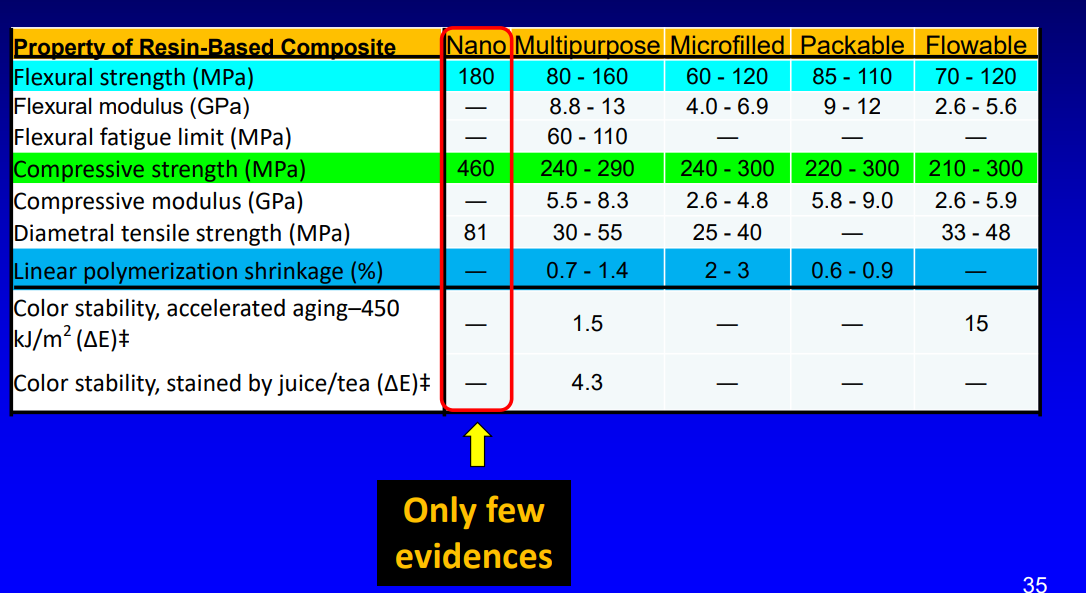
what is the evolution of curing systems
self cured→ uv cured → VLC
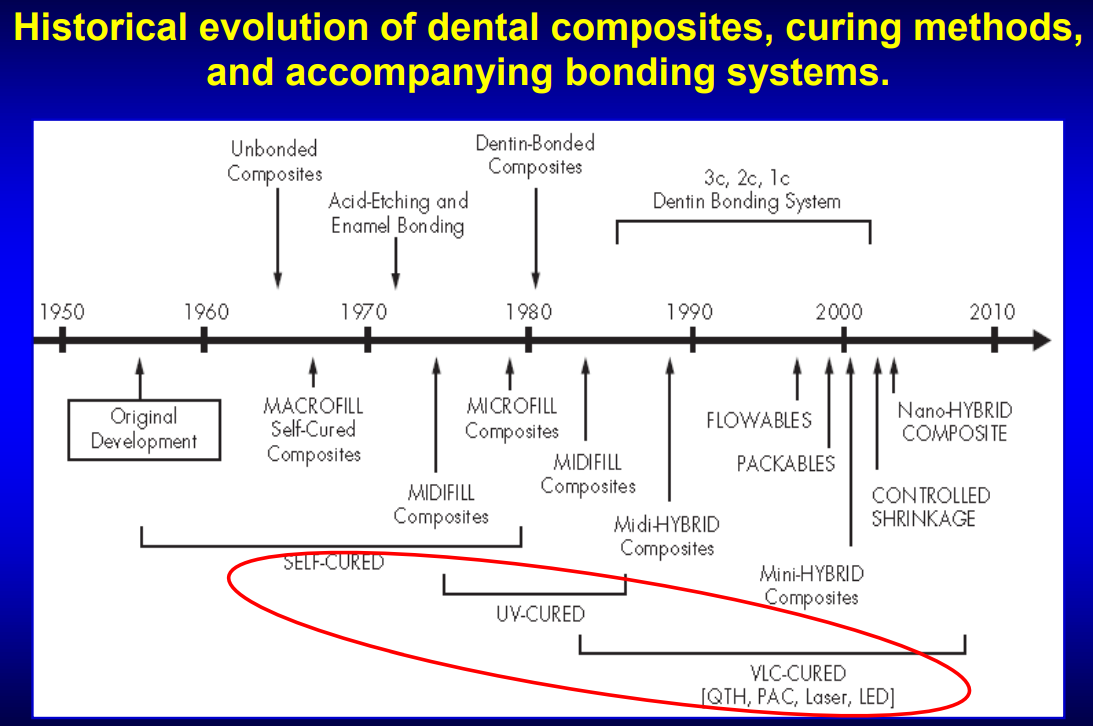
what are the three methods of polymerization
chemical cured
UV cured
visible light-cure
what does amine function as when thinking about methods of polymerization
funx as a proton donor and an accelerator of free-radical production
what are the two ingredients in base (universal) paste
monomer
treated inorganic particles (silica & alumina)
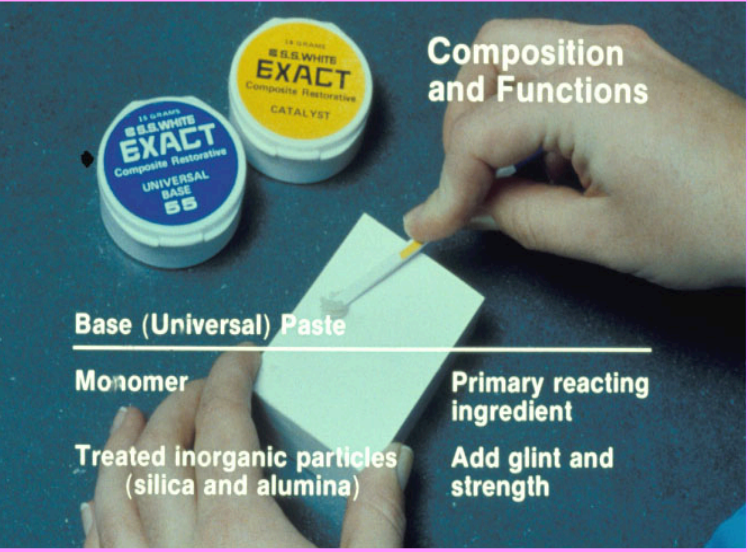
in base (universal) paste, the monomer acts as the…
primary ingredient
in base (universal) paste, the treated inorganic particles (silica and alumina) are added for what
to add glint and strength
what are the four ingredients in catalyst paste
monomer
treated inorganic particles
barium compounds
catalyst
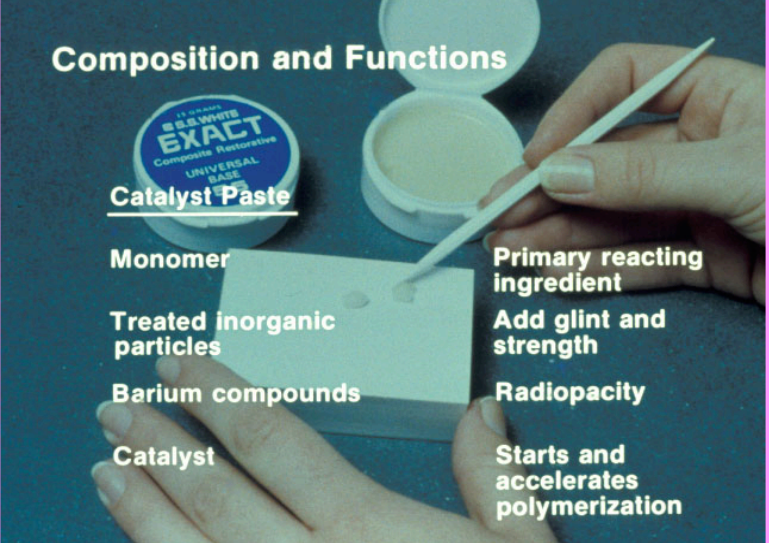
in catalyst paste, what does the monomer act as
primary reacting ingredient
in catalyst paste, what does the treated inorganic particles act as
add glint and strength
in catalyst paste, what do the barium compounds act as
radiopacity
in catalyst paste, what does the catalyst act as
starts and accelerates polymerization
reaction of composites
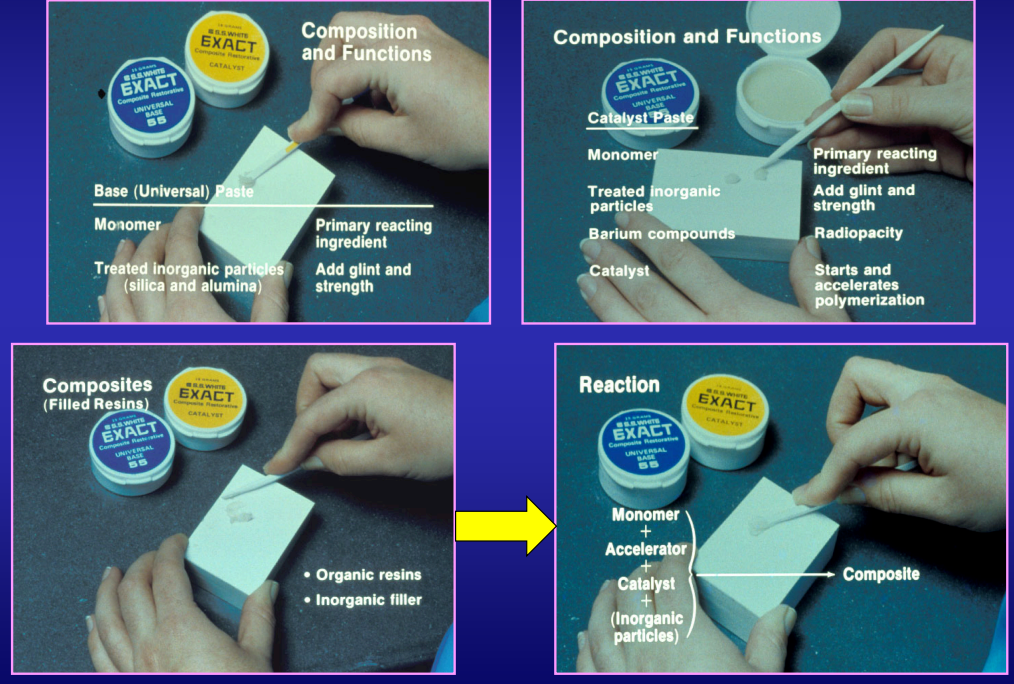
visible light curing composite (photopolymerization) properties (3)
no mixing, less porosity, better shade control
less finishing time, contoured before curing
more color stable and wear resistance
why is delivering sufficient energy to resin-based composites (RBC) important
based on many scientific publications, light-cured RBC must receive adequate light energy to achieve their intended physical, chemical, and optical properties
what are the two types of light-curing units (LCU)
quartz tungsten-halogen (QTH)
light emitting diode (LED)
LED graph
lower wavelength and still gives off high power
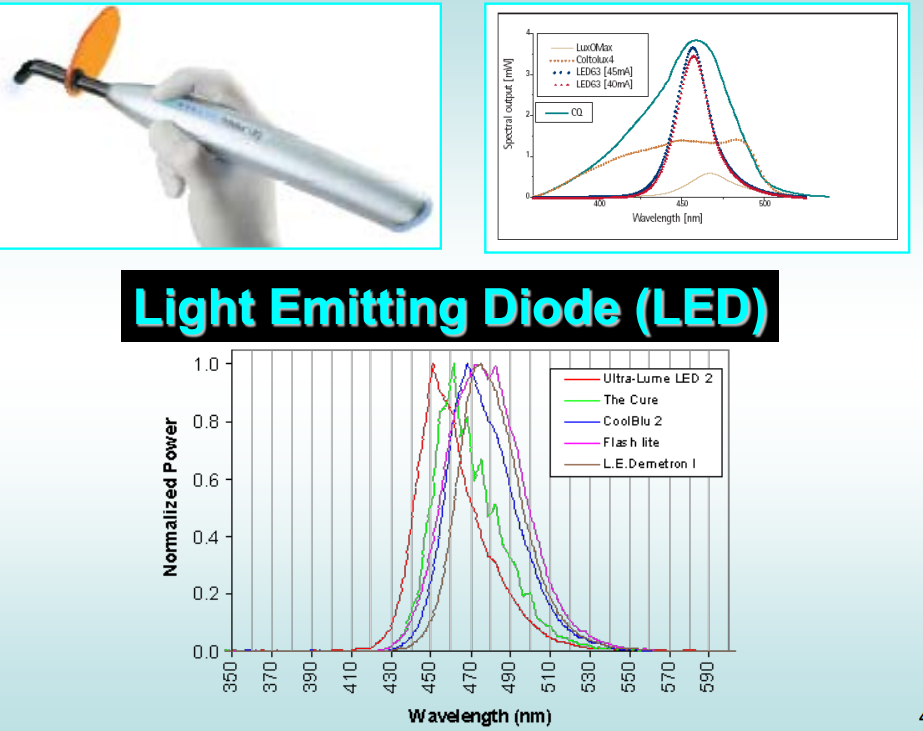
what are the 5 light considerations
emission spectrum
spectral radiant power
radiant exitance
irradiance
radiant exposure
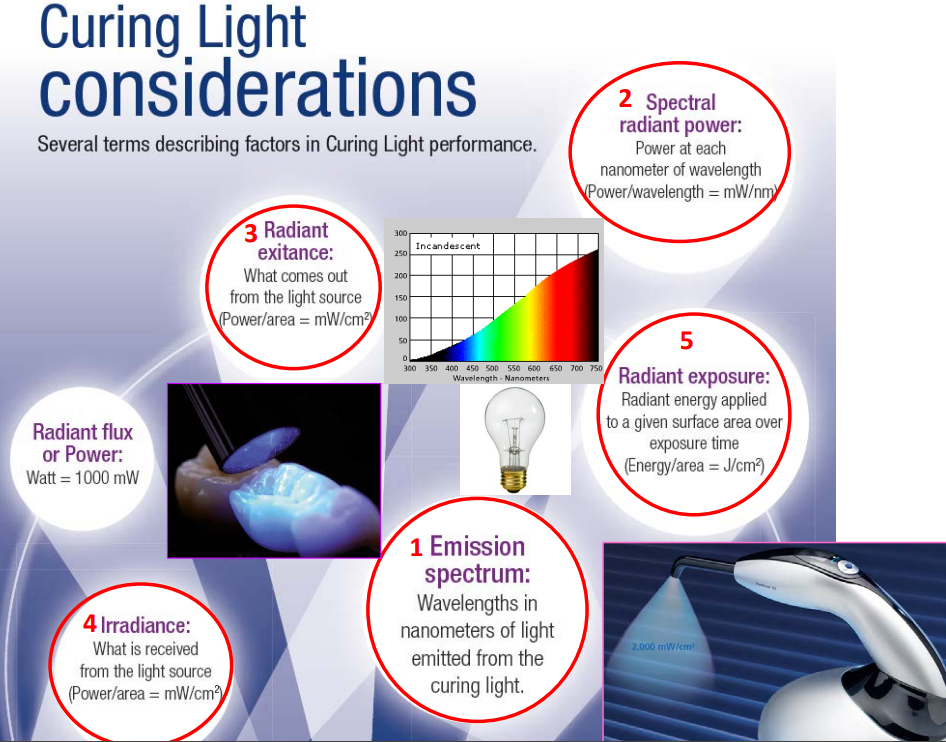
what is emission spectrum
wavelengths in nanometers of light emitted from the curing light
what is spectral radiant power
power at each nanometer of wavelength (power/wavelength = mW/nm)
what is radiant exitance
what comes out from the light source (power/area = mW/cm2)
what is irradiance
what is received from the light source (power/area = mW/cm2)
what is radiant exposure
radiant energy applied to a given surface area over exposure time (energy/area = J/cm2)
radiant flux or power =
watt = 1000 mW
most LED or laser LCU produce a very narrow spectral emission and are usually optimized to cure…
the commonly used camphorquinone photoinitiator that is most reactive to light at ~468 nm
some RBCs use alternative photoinitiators that require v different wavelengths, it is possible to use…
an LED or laser unit that is not ideally matched to the RBC and in some cases the RBC will not cure at all
when talking about the spectral radiant power, all LCU emit blue light but this does not mean…
the spectral ranges and spectral radiant powers are the same
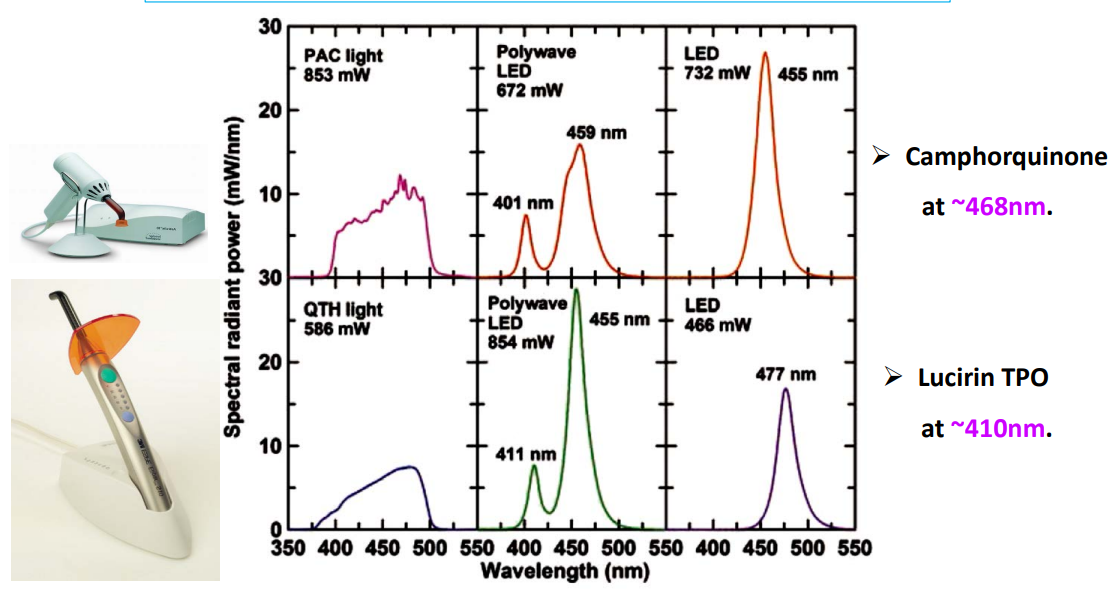
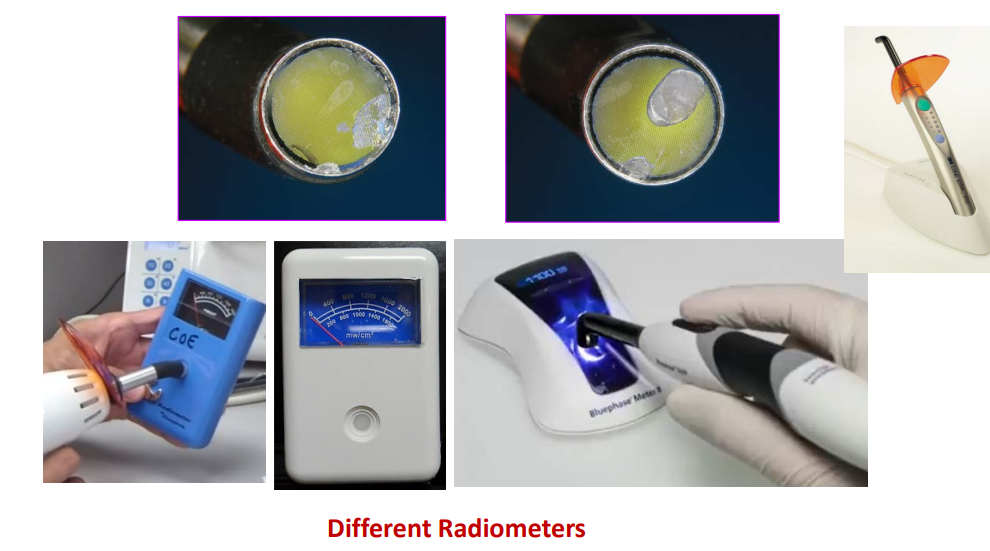
when thinking about radiant exitance, you want to ensure your LCU is in good working order…
clinicians should monitor the output of their LCUs using a radiometer on a regular basis; helps ensure the unit is funx optimally (make sure to remove adherent resin from tip-end surfaces)
when thinking of irradiance, we are specifically thinking about…
distance over angulation
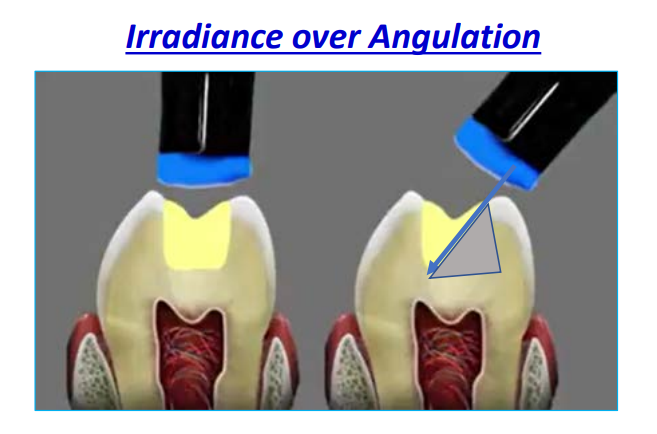
the proximity of curing light to the surface affects…
the depth and penetration of light into the surface
in irradiance, there is an inverse relationship between…
distance and light intensity (distance inc, light intensity dec)
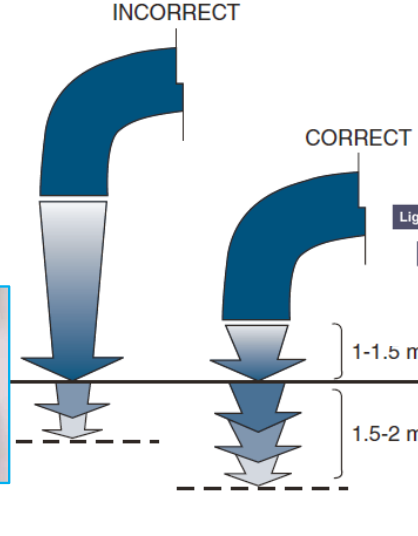
when the curing light passes through the composite, the light is attenuated significantly depending on…
the filler type, filler loading, hue of the composite, refractive properties, opacity, and translucency
what is the total energy concept
light curing process depends on the energy, this is determined by the radiant exposure/energy density received by the restoration and is the mathematical product of the curing light irradiance and exposure time

how to calculate curing time
apply all traditional composites w a layer of thickness of 2 mm and w the light probe directly on the restoration
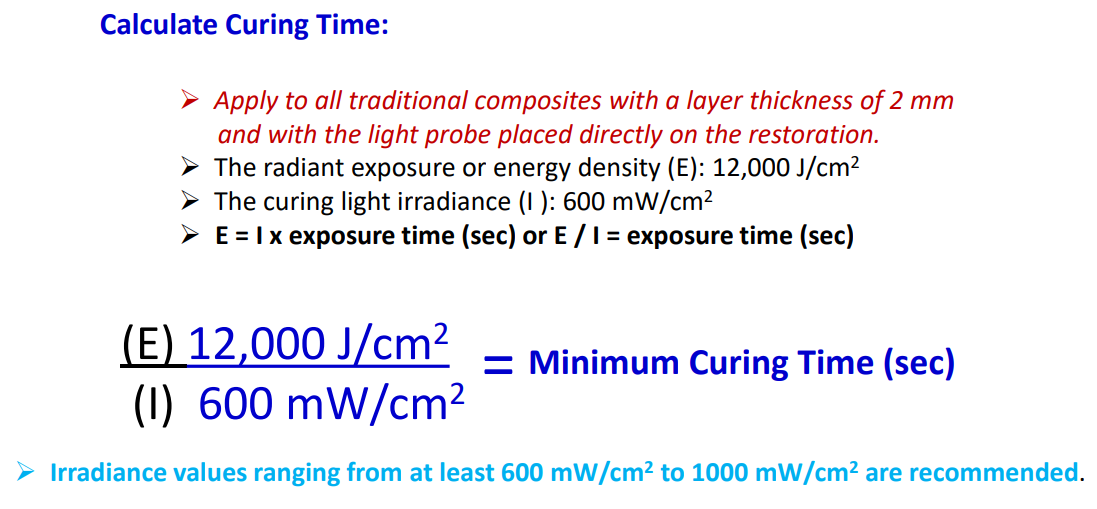
inadequate polymerization will ultimately lead to
dec degree of conversion, dec physical and mechanical properties
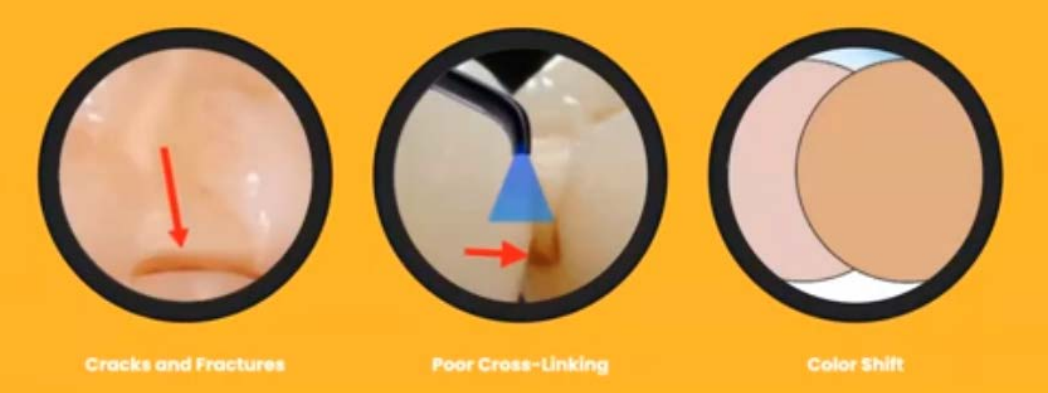
light-cured RBC materials require the correct ________ and _________ to achieve their intended…
correct type (wavelength) and amount of light energy to achieve their intended physical, chemical, and optical properties
important things to remember for an effective use of dental curing lights
protect your eyes
position the pt
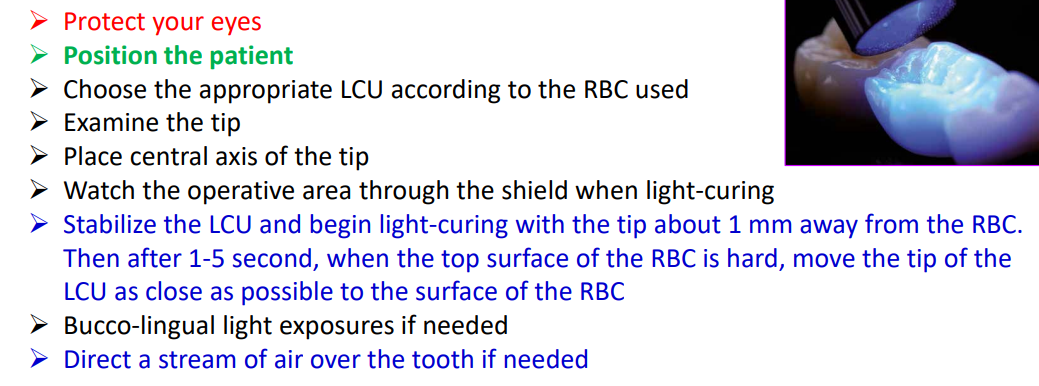
tooth preparation conservative steps
moisture control → etch enamel and dentin properly → adhesive selection → polymerize correctly → proper insert and cure for composite
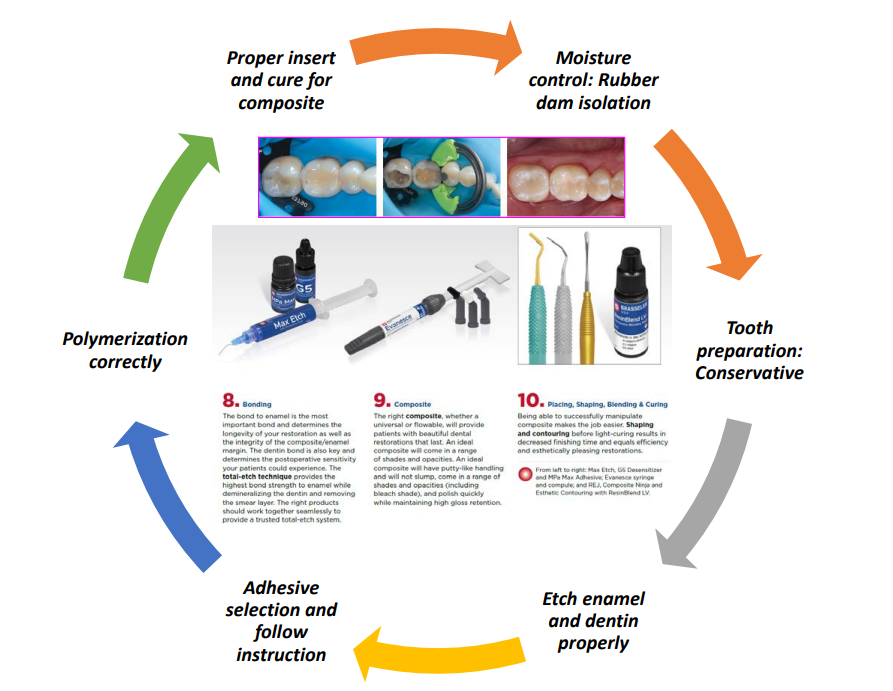
a general rule for composites and light curing
apply a layer of all traditional composites of 2mm thickness and w the light probe placed directly on the restoration
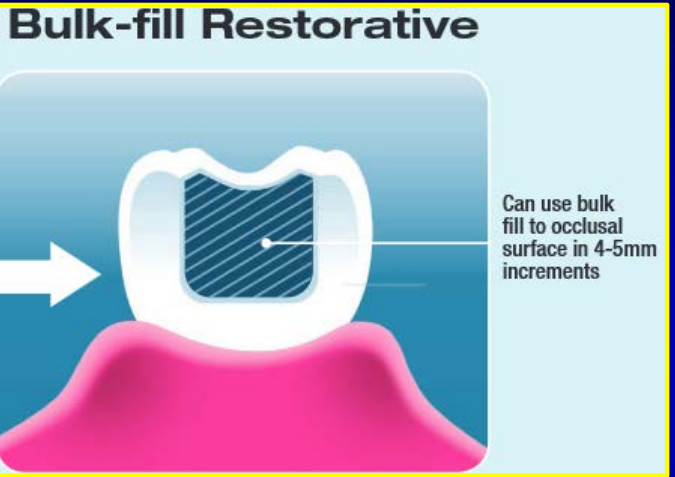
bulk-fill restorative composite characteristics (5)
inc depth of cure (>/= 4 mm)
lower polymerization shrinkage
acceptable esthetics
inc wear resistance (?)
good handling and adaptability
advantages of bulk-fill restorative composite (3)
less technique sensitive, reduced chair time, fewer voids
disadvantages of bulk fill restorative composite
esthetics (sometimes can be too translucent), limited choice of shades
bulk fill composites are not all the same and it is important to understand how to use them accordingly, the differences can be seen in…
viscosity of the material and its delivery
why is the depth of cure greater in bulk-fill restorative composite
due to less filler content and a higher level of photo initiators
bulk-fill restorative composites are highly elastic, why is this important
it will mitigate polymerization shrinkage effects bc shrinkage effects are compensated by the elasticity of the material
it is recommended to place ________(high/low) viscosity bulk-fill composite to achieve better wear resistance when used on high-stress areas
high-viscosity
it is recommended to place __________(high/low) viscosity bulk-fill composites to achieve intimate adaptation to the gingival and pulpal floors
low-viscosity
high-viscosity restorative composites result in how many cured layers
two cured layers- although they are bulk fills
high-viscosity bulk fill composites have better wear resistance but do not adapt well to…
do not adapt well to the cavity walls
what are resin monomers made up of
Bis-GMA (bisphenol-glycidyl dimethacrylate)
bisphenol- A (BPA) is associated w the manufacture of some plastics- including composites, but there have been some safety concerns about BPA…
BPA is a chemical sometimes involved in making plastics and dental materials. In lab studies, BPA acts like estrogen which raised safety concerns. BUT, these effects have not been seen in humans.
There may be small amounts of BPA exposure from dental materials due to saliva breaking them down.
The ADA currently has no concerns about BPA exposure from dental materials.
when considering prepping a tooth it is important to think about the amount of tooth structure is left and the likely-hood that the restoration will benefit the pt more than doing a crown. what depth of the tooth is still okay to do a filling
if it is less than ½ depth into the tooth

when considering prepping a tooth it is important to think about the amount of tooth structure is left and the likely-hood that the restoration will benefit the pt more than doing a crown. what depth of the tooth would you consider doing a crown
½ - 2/3 depth
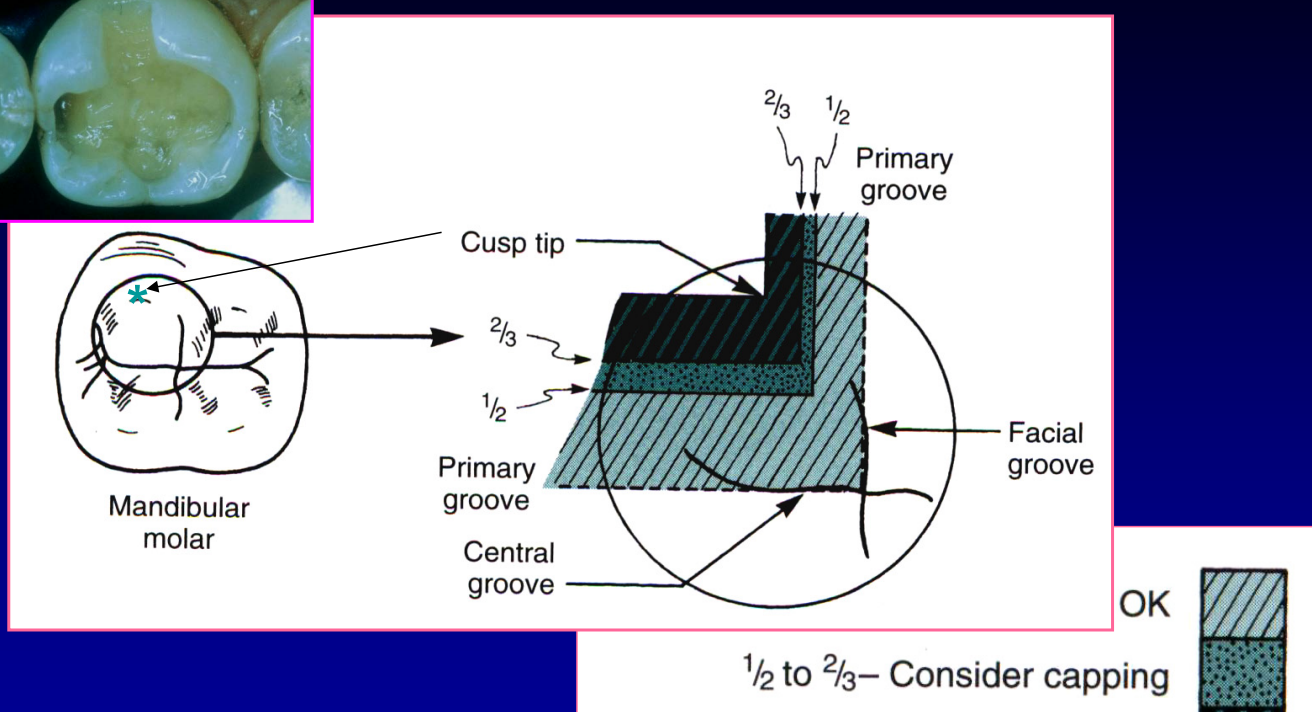
when considering prepping a tooth it is important to think about the amount of tooth structure is left and the likely-hood that the restoration will benefit the pt more than doing a crown. what depth of the tooth would you recommend doing a crown
2/3 or more
